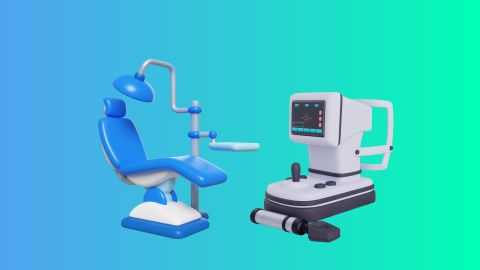A suction machine is a crucial medical device used across hospitals, clinics, and home care to keep airways and surgical sites clear of fluids. This guide explains what suction machines are, their types, key uses, and the benefits they offer in emergency, surgical, and respiratory care. It also covers pricing in India, important buying considerations, maintenance tips, and financing options. Whether you're a healthcare provider or clinic owner, this resource helps you choose the right machine and invest wisely. For Indian healthcare providers, a suction machine is an essential component of patient care, especially in critical care and surgical environments, and is widely available through medical equipment suppliers.
What is a suction machine?
A suction machine is a vital piece of medical equipment used to remove fluids such as mucus, blood, saliva, or other secretions from a patient’s airway or surgical site. It is commonly used in hospitals, clinics, ambulances, and home healthcare settings. These machines ensure that the airway remains clear during surgery, emergencies, or respiratory conditions. Suction machines can be either manual or electrically powered, depending on the application and setting. For Indian healthcare providers, a suction machine is an essential component of patient care, especially in critical care and surgical environments, and is widely available through medical equipment suppliers.
Types of suction machines
Suction machines are available in various types based on their operation, power source, and clinical use. Choosing the right type depends on the healthcare environment, portability requirements, and suction strength needed for the procedure.
- Manual suction machines – Operated by hand or foot pump; suitable for emergencies or areas without electricity.
- Electric suction machines – Powered by electricity; offer consistent suction for hospitals and clinics.
- Battery-operated suction machines – Rechargeable and portable; ideal for ambulances and home care.
- Wall-mounted suction units – Installed in operation theatres and ICUs; connected to central vacuum systems.
- Portable suction machines – Compact and easy to carry; suitable for fieldwork and patient transfers.
- High-vacuum surgical suction machines – Designed for use during surgical procedures to remove large volumes of fluid.
Before finalising your purchase, it’s a smart idea to check your medical equipment finance eligibility—this helps you assess what financing options and EMI plans are available based on your specific needs.
Uses of suction machine
Suction machines play a critical role in emergency care, surgical procedures, and respiratory treatment. Their ability to maintain a clear airway or surgical site improves safety and facilitates effective treatment.
- Airway clearance – Removes mucus, blood, or vomit in emergency or ICU settings to prevent choking.
- Surgical procedures – Keeps the surgical site clear of fluids for better visibility and reduced infection risk.
- Tracheostomy care – Helps remove secretions in patients with tracheostomy tubes.
- Respiratory care – Assists patients with conditions like COPD or pneumonia in clearing their airways.
- Dental procedures – Removes saliva and blood during oral surgeries.
- Wound care – Used in vacuum-assisted wound therapy to extract exudates and promote healing.
Benefits of using a suction machine
Using a suction machine offers numerous advantages in both emergency and routine medical care. It supports respiratory function, prevents infections, and improves procedural efficiency for medical staff.
- Improves airway management – Helps prevent aspiration and ensures safe breathing.
- Supports surgical efficiency – Maintains a clean surgical field, reducing complications.
- Enables quick emergency response – Useful in ambulances and emergency rooms for fast suctioning.
- Reduces infection risk – Removes fluids that may harbour bacteria or delay healing.
- Enhances patient comfort – Eases breathing in patients with secretion build-up.
- Adaptable to various settings – Available in portable and hospital-grade formats for flexible use.
How to use a suction machine?
Here are the steps to use a suction machine effectively:
Prepare the Equipment: Ensure the suction machine is clean and fully charged or connected to a power source. Assemble all parts including the suction tubing, canister, and catheter.
Wash Your Hands: Always wash or sanitize your hands before starting the procedure to maintain hygiene and prevent infection.
Position the Patient: Place the patient in a comfortable and safe position, preferably semi-upright, to facilitate effective suctioning.
Turn On the Machine: Switch on the suction machine and check for proper suction pressure as per medical guidelines.
Insert the Catheter: Gently insert the catheter into the mouth, nose, or tracheostomy tube depending on the required suctioning route.
Apply Suction: Cover the suction port with your thumb to activate suction while withdrawing the catheter in a circular motion.
Dispose and Clean: Safely dispose of used catheters and clean the machine as per manufacturer instructions.
How does a suction machine work?
Here’s how a suction machine operates, explained in pointers:
Creates Negative Pressure: The machine generates vacuum or negative pressure using a motor or pump mechanism.
Draws Out Secretions: This vacuum helps draw out fluids like mucus, saliva, blood, or pus from airways or surgical sites.
Uses a Suction Catheter: A sterile catheter is attached to the tubing and inserted into the patient’s airway or wound.
Collects Fluids in Canister: The removed secretions are safely collected in a sealed canister attached to the machine.
Regulated Pressure Control: Most machines allow adjustment of suction pressure to suit adult or pediatric use.
Powered Operation: Suction machines may run on electricity or batteries, making them usable in both clinical and home settings.
Ensures Airway Clearance: The main goal is to keep airways clear, preventing blockages and ensuring proper breathing, especially in patients with respiratory conditions.
Suction Machine Price Range in India
The price of suction machines in India depends on their type, capacity, brand, and additional features such as portability or vacuum strength. Below is a general pricing guide to help buyers make informed decisions.
| Type of suction machine | Price range (Approximate) |
| Advanced portable suction unit for multi-bed wards | Rs. 2 lakh – Rs. 4 lakh |
| High-capacity electric suction machine for operation theatres | Rs. 4 lakh – Rs. 10 lakh |
| Central suction system for mid-sized hospitals | Rs. 10 lakh – Rs. 25 lakh |
| Wall-mounted multi-point suction units for ICUs | Rs. 20 lakh – Rs. 50 lakh |
| Customised centralised suction pipeline systems (large hospitals or medical colleges) | Rs. 50 lakh – Rs. 2 crore |
To make this investment easier, especially for small clinics or expanding hospitals, you can check your pre-approved doctor loan offer and get faster access to funds with minimal documentation.
Things to consider before buying a suction machine
When selecting a suction machine, healthcare professionals must assess operational needs, patient demographics, and power requirements. Choosing the right model enhances treatment quality and reduces breakdowns during critical moments.
- Type of usage – Determine if the machine is for surgical, emergency, or home care use.
- Power source – Choose between manual, electric, or battery-operated depending on location.
- Suction power – Opt for high-vacuum models for surgery and standard suction for routine care.
- Portability – Consider a lightweight unit if mobility is required.
- Noise levels – Quieter models are preferred in patient-centric environments.
- After-sales service – Ensure the brand offers warranty, spare parts, and local service support.
Check your medical equipment finance pre-approved offer – Take advantage of pre-approved financing options to help manage your budget while securing the best equipment for your facility.
Maintenance tips for suction machine
Regular maintenance of suction machines ensures safety, durability, and uninterrupted operation. Proper care reduces the risk of infection and equipment failure in critical moments.
- Clean after each use – Disinfect tubing, canisters, and external surfaces.
- Inspect filters – Check and replace air filters periodically to maintain suction efficiency.
- Check connections – Ensure all tubes and fittings are secure and leak-free.
- Monitor battery life – Charge battery-operated units fully and avoid overuse without recharging.
- Test suction levels – Run routine checks to confirm vacuum strength and performance.
- Schedule annual servicing – Engage certified technicians for deep cleaning and part replacements.
Financing options for suction machine
Purchasing a high-quality suction machine can be a financial challenge for small clinics or home care providers. We offer dedicated medical equipment finance options to make equipment more accessible. These include:
Flexible EMIs and repayment tenures of up to 120 months
Loan amounts up to Rs. 30 crore depending on eligibility
Collateral-free financing for select applicants
Quick approval and disbursal within 48 hours
Pre-approved offers for existing Bajaj Finserv customers
Minimal documentation and fully digital application process
Conclusion
A suction machine is a critical tool in modern healthcare, offering life-saving support in surgeries, respiratory care, and emergencies. With various models available, it caters to different clinical and home settings. Choosing the right type and maintaining it properly ensures reliable performance. For healthcare providers looking to invest without financial stress, our doctor loan offers an efficient way to acquire essential devices while preserving working capital. Check your doctor loan eligibility now.




